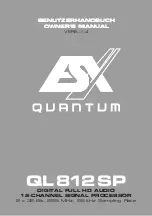
CHAPTER 17 |
121
GETTING THE SOUND YOU WANT
♦
Reduce the level of the Band Mix section, especially if you have increased the output of one or two
particular bands to achieve a particular sound.
♦
Raise the threshold of the Multiband Limiters to keep the audio from hitting the limiters as hard or as
often. (You may need to lower the Band Mix level to keep from driving the final clipper too hard when
making this adjustment).
♦
Lower the targets of the Multiband AGC compressors
♦
Use slower attack and release speeds in the Input AGC, Wideband AGC, and Multiband AGC sections.
♦
Use “looser” ratios in the Input AGC, Wideband AGC, and Multiband AGC sections.
Achieving Loudness
If loudness is an important processing goal, and you are willing to accept more processing artifacts and give up
some quality, here are some suggestions:
♦
Use “tighter” ratios in the Input AGC, Wideband AGC, and Multiband AGC sections.
♦
Use faster attack and release speeds in the Input AGC, Wideband AGC, and Multiband AGC sections.
♦
Raise the target of the Multiband AGC compressors.
♦
Lower the threshold of the Multiband Limiters. (You may need to raise the Band Mix to compensate for
the additional gain reduction this produces in the limiters).
♦
Increase the overall Band Mix level.
♦
Raise the Clipper Drive (AM core) or Final Limiter Drive (HD core) in 0.25dB steps until advancing the
control no longer yields additional loudness, only more distortion, and then back off a notch.
Spectral Consistency & Equalization
Stations often want to create their own “signature sound” on the air with a spectrally consistent output without
regard to the frequency balance of the original source material.
In the Basic mode, altering the spectral balance is done by way of the
Enhance
controls -
Deep Bass, Warmth,
Presence,
and
Brilliance.
If you are in the Intermediate or Expert modes, there are basically three ways to alter the spectral balance of your
sound with Omnia.7, and each provides a different end result: The
Parametric Equalizer,
the
Multiband AGC
Targets,
and the
Band Mix
control. Adjustments to each section can produce somewhat similar or very different
outcomes depending upon a variety of factors.
♦
The
Parametric EQ
is a very versatile and powerful means by which to shape your sound. You can set up a
shelving EQ to create low bass “slam,” set up a broad, gentle cut to the high-mids to smooth out horns or
female vocalists, or add some “air” or “sparkle” to your sound by adding a bit of a boost to the very top of
the spectrum.
Because the Parametric EQ is located fairly early in the processing chain and ahead of the Multiband AGC
and Limiters, these processing sections are likely to make some attempt to compensate for large changes
in the spectrum. However, because the crossover slopes of the multiband processors are relatively broad,
the Parametric EQ can have more impact than you might expect.
Finally, remember that EQ is a static process. That is, it increases or reduces gain to a particular part of the
spectrum irrespective of program content. In other words, if you apply 8dB of bass boost it is applied to
all incoming audio whether it is bass shy or bass heavy.










































